Getting the first look at January releases is one of the most exciting times of the year for book reviewers. The selection of hot-off-the-press books so far suggest 2017 will be a terrific year for children’s and young adult literature and readers can look forward to a year of great books from which to choose. Happy reading to all in this new year!
Ages 4–8
Mighty, Mighty Construction Site. Sherri Duskey Rinker. Ill. Tom Lichtenheld. 2017. Chronicle.
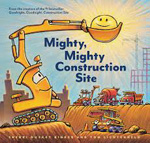 After the five hard-working construction vehicles from Goodnight, Goodnight, Construction Site (2011), Excavator, Bulldozer, Crane Truck, Dump Truck, and Cement Mixer, review plans for a supersized, complex building, they know they’ll need help to get the job done. Fortunately, they have five good friends to call on. “Rolling, rumbling, revving hard, / ten big trucks meet in the yard. / A mighty, massive SUPERCREW— / there is nothing they can’t do!” The rhyming text and sunny, earth-toned illustrations on double-page spreads playfully show the teamwork of the new machines (Skid Steer, Backhoe, Flatbed, Front-End Loader, and Pumper) and the original crew. “Cooperation got it done; / teamwork made it fast—and fun!” Project completed. Young fans will hope a new construction site project is being planned.
After the five hard-working construction vehicles from Goodnight, Goodnight, Construction Site (2011), Excavator, Bulldozer, Crane Truck, Dump Truck, and Cement Mixer, review plans for a supersized, complex building, they know they’ll need help to get the job done. Fortunately, they have five good friends to call on. “Rolling, rumbling, revving hard, / ten big trucks meet in the yard. / A mighty, massive SUPERCREW— / there is nothing they can’t do!” The rhyming text and sunny, earth-toned illustrations on double-page spreads playfully show the teamwork of the new machines (Skid Steer, Backhoe, Flatbed, Front-End Loader, and Pumper) and the original crew. “Cooperation got it done; / teamwork made it fast—and fun!” Project completed. Young fans will hope a new construction site project is being planned.
—CA
Rabbit Magic. Meg McLaren. 2017. Clarion/Houghton Mifflin Harcourt.
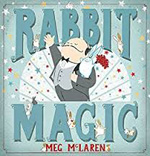 Houdini the Rabbit, the most perfect assistant of all, and a gang of backstage chubby bunnies work hard to help “Monsieur Lapin Presents Heads or Tails…Feeling Lucky?” succeed. When M. Lapin injures himself onstage by slipping on a banana peel, Houdini makes sure that the show goes on—and accidentally transforms M. Lapin into a rabbit. Now the boss, Houdini creates a daring show (with allusions to feats performed by the legendary Houdini) with M. Lapin as his assistant, but it isn’t long before he realizes M. Lapin is the one who needs the spotlight more. During the grand finale of his sold-out tour, Houdini restores Monsieur Lapin to his human status. A lesson on generosity and teamwork is acknowledged by M. Lapin when his new billboard reads “Monsieur Lapin & Friends Present EVERYONE IS MAGIC featuring Houdini and the Hoppers.” The softly colored digitally created illustrations featuring portly, mustached Monsieur Lapin and Houdini, a white rabbit outlined in blue (which makes him clearly distinguishable from the large supporting cast of cute rabbits) extend the humor of this role-reversal story. Compare the front and back endpapers to visually capture the gentle moral of this magical picture book.
Houdini the Rabbit, the most perfect assistant of all, and a gang of backstage chubby bunnies work hard to help “Monsieur Lapin Presents Heads or Tails…Feeling Lucky?” succeed. When M. Lapin injures himself onstage by slipping on a banana peel, Houdini makes sure that the show goes on—and accidentally transforms M. Lapin into a rabbit. Now the boss, Houdini creates a daring show (with allusions to feats performed by the legendary Houdini) with M. Lapin as his assistant, but it isn’t long before he realizes M. Lapin is the one who needs the spotlight more. During the grand finale of his sold-out tour, Houdini restores Monsieur Lapin to his human status. A lesson on generosity and teamwork is acknowledged by M. Lapin when his new billboard reads “Monsieur Lapin & Friends Present EVERYONE IS MAGIC featuring Houdini and the Hoppers.” The softly colored digitally created illustrations featuring portly, mustached Monsieur Lapin and Houdini, a white rabbit outlined in blue (which makes him clearly distinguishable from the large supporting cast of cute rabbits) extend the humor of this role-reversal story. Compare the front and back endpapers to visually capture the gentle moral of this magical picture book.
—NB
Short Stories for Little Monsters. Marie-Louise Gay. 2017. Groundwood/House of Anansi.
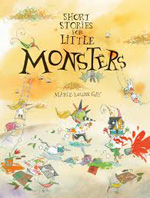 This collection of 19 short stories, presented in paneled cartoon format, invites young children to consider all sorts of things that their imaginations might lead them to ponder as they explore the world about them. What do cats see? What nightmares do snails have? Do rabbits have a secret life in their underground tunnels? The text is presented primarily in speech bubbles. Although most of the text involves conversations among children, there are also clever comments from nonhumans, such as witty banter among various species of trees in “What Do Trees Talk About?” The brightly colored, detailed artwork (done in watercolor, colored pencil, and collage) is childlike. The stories, which vary from silly to whimsical to wry, make this an engaging, thought-provoking picture book to read again and again.
This collection of 19 short stories, presented in paneled cartoon format, invites young children to consider all sorts of things that their imaginations might lead them to ponder as they explore the world about them. What do cats see? What nightmares do snails have? Do rabbits have a secret life in their underground tunnels? The text is presented primarily in speech bubbles. Although most of the text involves conversations among children, there are also clever comments from nonhumans, such as witty banter among various species of trees in “What Do Trees Talk About?” The brightly colored, detailed artwork (done in watercolor, colored pencil, and collage) is childlike. The stories, which vary from silly to whimsical to wry, make this an engaging, thought-provoking picture book to read again and again.
—CA
Ages 9–11
Matylda, Bright & Tender. Holly M. McGhee. 2017. Candlewick.
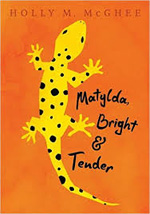 Sussy and Guy, best friends since kindergarten and now in fourth grade, buy a leopard gecko they name Matylda, who immediately bonds with Guy. At the end of the school year, Guy dies when he heroically saves Sussy from a dog attack. Staggering through a summer of grief, Sussy makes a deal with Matylda to keep Guy’s memory alive by finding better ways to love her. That’s when Sussy hears a voice in her head (“the stealing girl”) directing her to shoplift worms, mealies, and toys from the pet store for Matylda. After the already-ailing gecko rejects a load of stolen toys, Sussy goes into a rage, scaring the gecko so much that her tail falls off. Sussy finally realizes that Guy is truly gone and that she might also lose Matylda. When her crimes are uncovered, Sussy finds herself loved and understood by her mother and father as well as Mike, the owner of the pet store. In a brave move forward, Sussy begins fifth grade and discovers she can have a new life with new friends and a new relationship with Matylda.
Sussy and Guy, best friends since kindergarten and now in fourth grade, buy a leopard gecko they name Matylda, who immediately bonds with Guy. At the end of the school year, Guy dies when he heroically saves Sussy from a dog attack. Staggering through a summer of grief, Sussy makes a deal with Matylda to keep Guy’s memory alive by finding better ways to love her. That’s when Sussy hears a voice in her head (“the stealing girl”) directing her to shoplift worms, mealies, and toys from the pet store for Matylda. After the already-ailing gecko rejects a load of stolen toys, Sussy goes into a rage, scaring the gecko so much that her tail falls off. Sussy finally realizes that Guy is truly gone and that she might also lose Matylda. When her crimes are uncovered, Sussy finds herself loved and understood by her mother and father as well as Mike, the owner of the pet store. In a brave move forward, Sussy begins fifth grade and discovers she can have a new life with new friends and a new relationship with Matylda.
—NB
Revenge of the Green Banana. Jim Murphy. 2017. Clarion/Houghton Mifflin Harcourt.
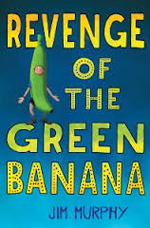 It is the 1950s, and sixth grader Jimmy Murphy is determined to turn over a new leaf. Within a few minutes of his entry into Sister Angelica Rose’s class, his plans are dashed. He’s sure his teacher, who has a red folder detailing his past crimes, is out to get him when he is sent to the second grade to help students prepare for a production of the Green Banana play. After Jimmy reveals a plan of revenge to his friends (to murderlate his teacher at the school production where she will be introducing a new bowling alley for girls), they jump in with enthusiasm to build a weapon of destruction. In the meantime, Sister Angelica Rose enlists Jimmy to help teach her basketball skills so she can begin a girls’ team, and he realizes that she is more than just a stern teacher and nun—she is a caring person, too. Is it too late to derail the plan? Readers are bound to chuckle throughout their madcap ride with a rollercoaster turn of events at the end, in this story told from Jimmy’s point of view. A warning on the opening page states that events in the story actually happened to the author as a child.
It is the 1950s, and sixth grader Jimmy Murphy is determined to turn over a new leaf. Within a few minutes of his entry into Sister Angelica Rose’s class, his plans are dashed. He’s sure his teacher, who has a red folder detailing his past crimes, is out to get him when he is sent to the second grade to help students prepare for a production of the Green Banana play. After Jimmy reveals a plan of revenge to his friends (to murderlate his teacher at the school production where she will be introducing a new bowling alley for girls), they jump in with enthusiasm to build a weapon of destruction. In the meantime, Sister Angelica Rose enlists Jimmy to help teach her basketball skills so she can begin a girls’ team, and he realizes that she is more than just a stern teacher and nun—she is a caring person, too. Is it too late to derail the plan? Readers are bound to chuckle throughout their madcap ride with a rollercoaster turn of events at the end, in this story told from Jimmy’s point of view. A warning on the opening page states that events in the story actually happened to the author as a child.
—NB
Ages 12–14
Factory Girl. Josanne La Valley. 2017. Clarion/Houghton Mifflin Harcourt.
 To save her family’s farm from government seizure, 16-year-old Roshen leaves her Muslim Uyghur family in East Turkestan to work as an indentured servant for one year in a factory that makes uniforms in south China. The restrictive nature of life at the Hubel Workwear Company, where the Uyghur girls are not permitted to wear headscarves and must speak only Mandarin, and the harshness of conditions at the factory (long hours, starvation diets, no privacy, severe punishment for breaking rules enforced by a cruel matron, and bosses who exploit them) are physically, psychologically, and culturally damaging. Roshen, who becomes a leader among the other Uyghur girls, finds solace in writing poetry secretly and resisting the injustices they face in any way she can. An author’s note on the government of the People’s Republic of China’s suppression of the Uyghurs’ culture and Muslim religion and silencing of dissent in East Turkestan provides a context for the novel.
To save her family’s farm from government seizure, 16-year-old Roshen leaves her Muslim Uyghur family in East Turkestan to work as an indentured servant for one year in a factory that makes uniforms in south China. The restrictive nature of life at the Hubel Workwear Company, where the Uyghur girls are not permitted to wear headscarves and must speak only Mandarin, and the harshness of conditions at the factory (long hours, starvation diets, no privacy, severe punishment for breaking rules enforced by a cruel matron, and bosses who exploit them) are physically, psychologically, and culturally damaging. Roshen, who becomes a leader among the other Uyghur girls, finds solace in writing poetry secretly and resisting the injustices they face in any way she can. An author’s note on the government of the People’s Republic of China’s suppression of the Uyghurs’ culture and Muslim religion and silencing of dissent in East Turkestan provides a context for the novel.
—CA
Midnight Without a Moon. Linda Williams Jackson. 2017. Houghton Mifflin Harcourt.
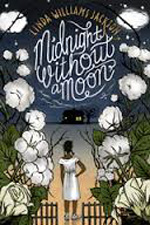 Thirteen-year-old African American sharecropper Rose Lee Carter toils long days in the fields during the summer of 1955 in the Mississippi Delta, where she lives with her grandparents (hardworking Papa and stern Ma Pearl), who are beholden to the Robinsons’ plantation for their measly wages and nicer-than-usual home. Life isn’t fair for Rose, as her lazy and light-skinned 15-year-old cousin, Queen, spends her days lounging around, and not much is expected of Rose’s not-so-bright younger brother, Fred Lee, either. Deserted years earlier by her mother and aware of the increasing numbers of racist-related murders, Rose is no stranger to hardship and death. At the same time, changes are on the horizon, and not everyone embraces them (including Ma Pearl), but Rose, who is at the top of her class, has dreams of moving up north and graduating from college one day. In August, Emmett Till, a 14-year-old African American boy, is murdered in Mississippi for reportedly whistling at a white woman. When his white assailants are acquitted by an all-white jury, the community is split between fear and activism. Rose, forbidden by Ma Pearl to return to school, is assigned permanently to the fields. When she has the opportunity to move up north, however, the consequences could be costly. For all middle school readers this historical novel can be a window for learning about the lives of those who struggled before them through segregation and Jim Crow laws and a mirror for reflecting on their own family histories during the pre–Civil Rights period of the 1950s.
Thirteen-year-old African American sharecropper Rose Lee Carter toils long days in the fields during the summer of 1955 in the Mississippi Delta, where she lives with her grandparents (hardworking Papa and stern Ma Pearl), who are beholden to the Robinsons’ plantation for their measly wages and nicer-than-usual home. Life isn’t fair for Rose, as her lazy and light-skinned 15-year-old cousin, Queen, spends her days lounging around, and not much is expected of Rose’s not-so-bright younger brother, Fred Lee, either. Deserted years earlier by her mother and aware of the increasing numbers of racist-related murders, Rose is no stranger to hardship and death. At the same time, changes are on the horizon, and not everyone embraces them (including Ma Pearl), but Rose, who is at the top of her class, has dreams of moving up north and graduating from college one day. In August, Emmett Till, a 14-year-old African American boy, is murdered in Mississippi for reportedly whistling at a white woman. When his white assailants are acquitted by an all-white jury, the community is split between fear and activism. Rose, forbidden by Ma Pearl to return to school, is assigned permanently to the fields. When she has the opportunity to move up north, however, the consequences could be costly. For all middle school readers this historical novel can be a window for learning about the lives of those who struggled before them through segregation and Jim Crow laws and a mirror for reflecting on their own family histories during the pre–Civil Rights period of the 1950s.
—NB
Ages 15+
The Truth of Right Now. Kara Lee Corthron. 2017. Simon Pulse/Simon & Schuster.
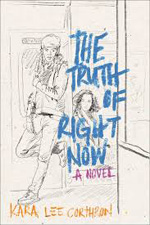 Privileged Jewish girl Lily, who is back at school after a suicide attempt following an affair with a teacher, and Dariomauritius (“Dari”), a mysterious transfer student whose Trinidadian father is a domineering and cruel tyrant, are drawn together by their love of the arts, cynicism against the hypocrisy of their privileged high school, and repercussions of broken families. An unlikely friendship during their junior year blooms into something more while each of them fights to find meaning and truth. Lily’s and Dari’s personal stories are told in alternating chapters. Lily (speaking in first person), once popular but now shunned by friends, has cut herself off from the music she once couldn’t stay away from. With the help of her therapist, she may finally be able to journal about the disastrous events of the previous year and begin to heal. Dari (whose story is delivered in third person), who carries a sketchpad everywhere he goes and has issues with authority and institutional racism, faces a disaster that may be too big to surmount. After a horrific misunderstanding triggers a series of events that lead to tragedy, Lily and Dari must figure out if their friendship can survive.
Privileged Jewish girl Lily, who is back at school after a suicide attempt following an affair with a teacher, and Dariomauritius (“Dari”), a mysterious transfer student whose Trinidadian father is a domineering and cruel tyrant, are drawn together by their love of the arts, cynicism against the hypocrisy of their privileged high school, and repercussions of broken families. An unlikely friendship during their junior year blooms into something more while each of them fights to find meaning and truth. Lily’s and Dari’s personal stories are told in alternating chapters. Lily (speaking in first person), once popular but now shunned by friends, has cut herself off from the music she once couldn’t stay away from. With the help of her therapist, she may finally be able to journal about the disastrous events of the previous year and begin to heal. Dari (whose story is delivered in third person), who carries a sketchpad everywhere he goes and has issues with authority and institutional racism, faces a disaster that may be too big to surmount. After a horrific misunderstanding triggers a series of events that lead to tragedy, Lily and Dari must figure out if their friendship can survive.
—NB
Under Rose-Tainted Skies. Louise Gornall. 2017. Clarion/Houghton Mifflin.
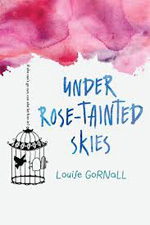 Seventeen-year-old Norah suffers from agoraphobia and obsessive-compulsive disorder, and she hasn’t been out of her home for four years. Her only face-to-face interactions are with her mother and a therapist. She attends online school and lives life vicariously (on social network) through friends who have forgotten her. When she accidentally meets the cute new neighbor, Luke, while she is literally reeling in a bag of groceries from the porch—and he brings them into her home—she bravely invites him into her world. Slowly, they develop a relationship, which is difficult considering that she can’t leave her home, is terrified of germs, has no control over panic attacks, doesn’t like anyone touching her, and shoulders constant self-doubt like a palpable weight. Luke is kind, sensitive, and patient as their friendship blossoms ever-so-slowly into romance. When Norah must escape from her home during an emergency, she draws on her strength to get to Luke’s home for help and, in the aftermath, decides to finally seek alternative remedies to her conditions that she had previously turned down. A realistic portrayal of mental health and illness, this poignant novel will resonate not only with readers who suffer from some of Norah’s symptoms but also those simply wanting to understand more about them.
Seventeen-year-old Norah suffers from agoraphobia and obsessive-compulsive disorder, and she hasn’t been out of her home for four years. Her only face-to-face interactions are with her mother and a therapist. She attends online school and lives life vicariously (on social network) through friends who have forgotten her. When she accidentally meets the cute new neighbor, Luke, while she is literally reeling in a bag of groceries from the porch—and he brings them into her home—she bravely invites him into her world. Slowly, they develop a relationship, which is difficult considering that she can’t leave her home, is terrified of germs, has no control over panic attacks, doesn’t like anyone touching her, and shoulders constant self-doubt like a palpable weight. Luke is kind, sensitive, and patient as their friendship blossoms ever-so-slowly into romance. When Norah must escape from her home during an emergency, she draws on her strength to get to Luke’s home for help and, in the aftermath, decides to finally seek alternative remedies to her conditions that she had previously turned down. A realistic portrayal of mental health and illness, this poignant novel will resonate not only with readers who suffer from some of Norah’s symptoms but also those simply wanting to understand more about them.
—NB
Nancy Brashear is Professor Emeritus of English from Azusa Pacific University, in Azusa, CA. Carolyn Angus is former director of the George G. Stone Center for Children's Books, Claremont Graduate University, in Claremont, CA.
These reviews are submitted by members of the International Literacy Association's Children's Literature and Reading Special Interest Group (CL/R SIG) and are published weekly on Literacy Daily.